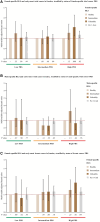Genetic risk, health-associated lifestyle, and risk of early-onset total cancer and breast cancer
- PMID: 39189966
- PMCID: PMC11717420
- DOI: 10.1093/jnci/djae208
Genetic risk, health-associated lifestyle, and risk of early-onset total cancer and breast cancer
Abstract
Background: Early-onset cancer (diagnosed under age 50) generally manifests as an aggressive disease phenotype. The association between healthy lifestyle and early-onset cancer and whether it varies by common genetic variants remains unclear.
Methods: We analyzed a prospective cohort of 66 308 participants who were under age 50 and free of cancer at baseline in the UK Biobank. Using Cox regression, we estimated hazard ratios (HRs) and 95% confidence intervals (CIs) for early-onset total and breast cancer based on sex-specific composite total cancer polygenic risk scores (PRSs), a breast cancer-specific PRS, and sex-specific health-associated lifestyle scores (HLSs).
Results: In multivariable-adjusted analyses with 2-year latency, higher genetic risk (highest vs lowest tertile of PRS) was associated with significantly increased risks of early-onset total cancer in females (HR, 95% CI = 1.83, 1.49 to 2.26) and males (2.03, 1.51 to 2.73) as well as early-onset breast cancer in females (3.06, 2.20 to 4.26). An unfavorable lifestyle (highest vs lowest category of HLS) was associated with higher risk of total cancer and breast cancer in females across genetic risk categories; the association with total cancer and breast cancer was stronger in the highest genetic risk category than the lowest: HRs (95% CIs) were 1.55 (1.12 to 2.14) and 1.69 (1.11 to 2.57) in the highest genetic risk category and 1.03 (0.64 to 1.67) and 0.81 (0.36 to 1.85) in the lowest.
Conclusions: Genetic and lifestyle factors were independently associated with early-onset total and breast cancer risk. Individuals with a high genetic risk may benefit more from adopting a healthy lifestyle in preventing early-onset cancer.
Published by Oxford University Press 2024.
Conflict of interest statement
The authors declare no potential conflicts of interest.
Figures



Update of
-
Genetic Risk, Health-Associated Lifestyle, and Risk of Early-onset Total Cancer and Breast Cancer.medRxiv [Preprint]. 2024 Apr 6:2024.04.04.24305361. doi: 10.1101/2024.04.04.24305361. medRxiv. 2024. Update in: J Natl Cancer Inst. 2025 Jan 1;117(1):40-48. doi: 10.1093/jnci/djae208. PMID: 38633776 Free PMC article. Updated. Preprint.
References
-
- Islami F, Goding Sauer A, Miller KD, et al.Proportion and number of cancer cases and deaths attributable to potentially modifiable risk factors in the United States. CA Cancer J Clin. 2018;68(1):31-54. - PubMed
-
- Sud A, Kinnersley B, Houlston RS.. Genome-wide association studies of cancer: current insights and future perspectives. Nat Rev Cancer. 2017;17(11):692-704. - PubMed
-
- Zhu M, Wang T, Huang Y, et al.Genetic risk for overall cancer and the benefit of adherence to a healthy lifestyle. Cancer Res. 2021;81(17):4618-4627. - PubMed
MeSH terms
Grants and funding
LinkOut - more resources
Full Text Sources
Medical

